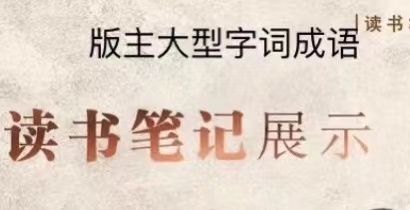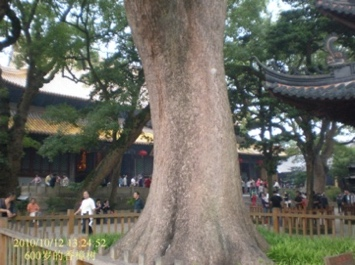The World Exposition held in Shanghai in 2010 is the forty-first Expo, from May 1 to Oct. 31, whose subject is Better City, Better Life! This was the first time China held the World Exposition, with far-reaching influence and much attention, whose visitors reached the number of 73 million.
On the evening of Oct. 8, 2010, we took the train and on the second day morning arrived at Shanghai South Railway Station. We took the special bus line to No. 8 Entry of Shanghai Expo and began stand in line for almost one hour before we could get in. We toured inside until 3 p.m. and on Oct. 10 we continued visiting inside the Expo until 7 p.m. with the lights bright everywhere, not wishing to leave. Because of the number of visitors was so high (Oct. 9 is 447,100 and Oc. 10 is 562,800) that before you could enter a country’s pavilion you had to stand in line for a long time. Naturally some lines are very long and some are somewhat shorter; some going forward faster and some slower. I was afraid of lining up because of my right wounded leg, esp. long line, no sign going forward.
We first entered the South Africa’s pavilion, then Chile, Venezuela and Cuba, not taking us a lot of time. The shape of the Canada’s pavilion looked unique, the line around it was long but moved forward quickly and before long we got in, which left us a good impression. The high and wide TV screen showed us the beautiful nature and city’s human landscapes of this maple country. Reaching the European region, we saw the Britain’s pavilion looked like a big hedgehog, also like a dandelion and were willing to get into it. However, we heard the broadcast saying that it would take four hours to lineup to visit it. We saw waiting visitors were round the pavilion, separated by handrails, forming several Z shape. Even if the line went forward without long stops, it would take a few hours to get to the entry. We had to gaze at the ocean and sigh ---- felt powerless and frustrated. The German pavilion was near and also surrounded by visitors and it was hard to find the end of the line, we had no choice to to give up. Visitors to the pavilion of Holland were walking up along a slope, watching at the same time and then down the slope also watching along side walking. The Holland’s pavilion was somewhat dissatisfying, small rooms along the slope and there were some art works, for example, some pictures of Van Gogh, and some featured products. Because we had been to Holland and Meilan Zhang thought of big wood shoes there, we saw at once two pairs of big wood shoes in the shop windows. We got tired when we walked down the Holland pavilion, and thought of the task our friends entrusted us to complete in Shanghai. We crossed the Huangpu River and got to Yuyuan Chenghuang Temple and to buy a hairpiece.
As a child, I got to know the Chenghuang Temple in Shanghai and there was a zigzag bridge in it. A neighbor of ours whose surname was Ma, had family members working in Shanghai. During the spring festival there was a picture of Chenghuag Temple on the wall of their home. Almost all the family had been to Shanghai and they described the Temple to me, making me admire them very much. When I grew up and have been to Shanghai several times, but had never been to the Chenghuang Temple.
The Chenghuang Temple has a well-deserved reputation and all buildings have black small tiles and bricks. There are pavilions, terraces and towers everywhere and both old streets with one-storey houses and shopping arcades in three and four storeys. There were all kinds of old-brand goods and all kinds of modern fashion brands. All streets are jammed with visitors, with streams of shoppers busily coming and going, jostling each other in a crowd. Some non-yellow races were among the people. Snacks were so many that they had become distinguishing feature of the Temple and a lot of people bought various snacks to chew all the time. I tried to find some snacks but because I had lived in the north for so long, Shanghai’s food flavor could not stimulate my saliva and I had not joined the team to chew the snacks. What I did was to take some photos on the zigzag bridge in order to turn my childhood’s dream into reality.
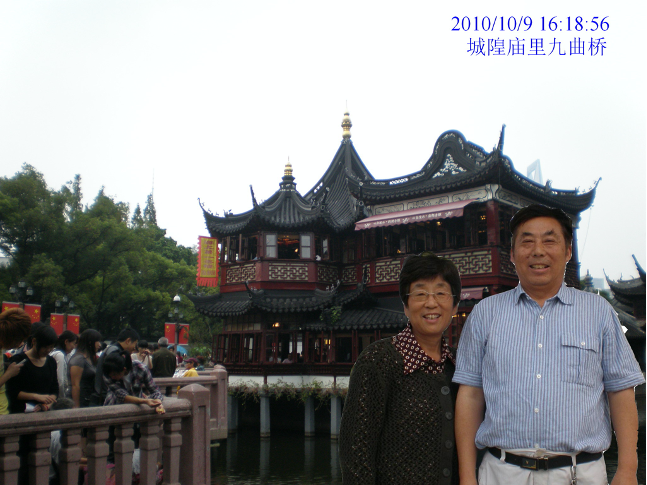
Zigzag bridge in Chenghuang Temple
On the early second day we still went in through Entry 8 and decided to follow the long dragon line to the American pavilion. The forward speed was OK and it took us not very long before we got to where an American girl was maintaining the order. She stopped us and asked us to wait as a next group. I had a chance to have a chat with the white girl, who said she came from the State of Michigan and majored in Chinese in her State University. As one of the Expo student ambassadors she came to Shanghai in the third group. I spoke English and she answered in Chinese, both of us practicing foreign languages.
For a while our group entered. Inside the receptionist was a young man, speaking Mandarin with American accent and sometimes even being able to ridicule. We entered three halls, watching large TV screens, similar to those of Canada pavilion. In one of the halls it was blowing and raining on the screen, we could feel wind blowing and rain dropping, which was said to be a 4D television. The subject of the last TV program was to promote the American spirit, first common people speaking and then Secretary of state Hilary Clinton and President Obama introducing the American belief.
It was said that the American Pavilion was completed later than all the others and finally Hilary Clinton coordinated personally, asking some distinguished corporations to pay out of their own pockets to build the pavilion. The last hall showed all the corporations’ name, advertising for them, namely Microsoft, Intel, Gold Eagle, Procter & Gamble,P&G, Walmart, Motorola and etc. In addition, we stayed in Marriott Hotel in Washington, which was also among them, into Chinese “万豪酒店”. Americans did things very seriously and they laid emphases on this Expo.
On 9th and 10th of Oct. we only visited some pavilions of C Region. We decided to take free traffic to Expo axis, which was the entry and the main axis, two storeys including the basement, semi-open buildings, located in the center of the Expo. It was 1000 m long and 110 m wide and on the +10.0 m platform, there was top cap with Tension Suspension Structure and sunshine valley built with light steel structure, whose construction cost amounted to 3 billion RMB, amount of Beijing’s Bird Nest plus Water Cube, making us inconceivable,which became a permanent architecture.
On the right side of Expo axis was Region A, where pavilions of Asian countries were located. China’s Pavilion was close to Expo axis, Macao’s, Hong Kong’s and Taiwan’s being also close to each other. If you hoped to visit China’s Pavilion, you had to make an appointment. Visitors were said to line up at six in the early morning, get the ticket from the appointment machine, on which the time your turn was confirmed and usually you had to wait for three to four hours. We followed our fixed policy to avoid the congest and to decrease fatigue, so we did not get into all the hot pavilions.
What made us feel fresh utmost was Nanpu Bridge and Lupu Bridge across the Huangpu River, which flows almost from west to east in this region, however we still call both sides Pudong (east) and Puxi (west), Not Punan (south) and Pubei (north). Before the development of Pudong, there were only ferries for the people to cross the Huangpu River. During the years of 1991, 1993, 1995 and 1997, it seemed that one great bridge spanned high over the Huangpu River every two years, Nanpu, Yangpu, Fengpu and Xupu were completed one after another and this Lupu Bridge was put into use in 2003.
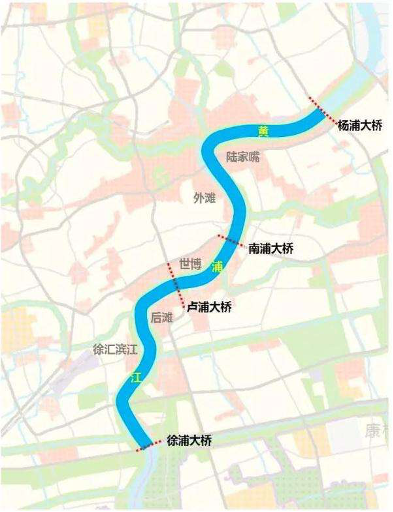
Fengpu Bridge in the south is not in this map
In addition, river bottom tunnels were completed one after another, namely Dapu Road, Yan’andong Road, the Bund Sightseeing, Outer Race, Dalian Road, Fuxingdong Road, Xiangyin Road, Shangzhong Road, Xizangnan Road, all of which had their tunnels through the Huangpu River. The special subway line, No. 13 had also the river bottom tunnels, becoming the fifth subway tunnel rail transit. The Huangpu River as a deep chasm turned into a thoroughfare and ferries on the River became tools of sightseeing. We decided to take the Expo free ferry to cross the Huangpu River to reach Region D and Region E.
When we arrived at the Australian Pavilion, it was 4 p.m. Although the number of visitors in line was decreased compared to the morning we had to be patient to wait in line. The Australian Pavilion showed the history of the young country, from 1788 up to now, 222 years. In the exhibition area “Discover”, the center of the Pavilion, there was an annular theatre which could hold 1000 people, showing grand banquets of vision and audition: Springing kangaroos, flourishing plants, Australian cities and the lives of the habitants living there, which you used you eyes and ears to “discover”.
On getting out of the Australian Pavilion we directly walked to the riverside. Without the annoyance of the long line we got on the ferry, enjoying the lovely scenes on the both sides of the Huangpu River. The Petroleum Pavilion was lighter up by neon lamps, but we could not get into it and we entered the United Enterprise Pavilion of Korea. On the 16th of Oct. the news came to us that visitors hoping to get into the Petroleum Pavilion had to wait in line seven and half hours.
When we left the Expo, the lights of both sides of the Huangpu River were all on, bright and resplendent everywhere. The sunshine valley of the Expo Axis became luminous cups, running light and color, forming the melody of the streaming light and shadow, and making us hope to continue to stay here.
It was 160 years since the first World Expo, i.e. the Great Exhibition, was held. Section forty-seven mentioned that the Eiffel Towerin Paris was the 1889 World's Expo’s building and the Atomium in Brussels was set up as a symbolic monument of the World Fair/Expo in 1958, both of which became the world’s most famous scenic spot. Now the 41st Expo was held next to our home and if we had lost the chance to visit it, it would have been a regretful thing. Altogether there were 267 pavilions and how many of them could we have been to? For any visitor, he or she could enter only a few of them, the list being far from being complete. My meaning is we have been there and have visited some of them, which is OK. It’s enough to feast on our eyes and to cause us to have a lot of thoughts and feelings.
On Oct. 13, we took a limousine in the South Inter-Province bus station of Shanghai at 8, and before long we entered Zhejiang Province. After about one hour on the ride we took a rest in a service area of Pinghu City. The Hangzhou Bay cross-sea bridge we had hoped to see was not far.
Heaven is not cooperative, and the mist decreased the visibility, although it was not raining. We sat in the front of the bus and had a good sight, however we could not see the far front scene. We felt that the road of the bridge was not far from the sea surface, and no ships could go under it. Soon appeared a high tower shaped in Chinese character “人”, one after another. Soon another similar two high towers entering our sight I had thought of as the south bridgehead, and expected erroneously that we would soon arrive the south bank. Looking at it carefully, we were still on the sea and there was a long distance from the south bank.
The bus passed by a sightseeing platform and finally the coastal beach came to our sight, the bank still far away. There was no sign indicating the point where the bridge was connected with the south bank highway. We saw houses and other architectures and judged that we got to the south bank. It took 20 minutes for the bus to run on the bridge. Online materials solved my puzzlement. The bridge has two passages for ships to go through, north passage and south passage. Under the firs two high towers is the north passage, and the span was 448m, ships with 35000 tons can go through; Under the second two high towers is the south passage, whose span is 318m and permits ships with 3000 tons to go through. The sighting platform seems not large but in fact it has an area of 10000 square meters, as large as two football courts. The bridge road is an expressway with six lanes, two ways, the design speed is 100 km per hour. The bridge is 36 km long and it is right for the bus to take about 20 minutes.
This cross-sea bridge had joined the two cities of Shanghai and Ningbo. The first longest cross-sea bridge in the world, 36 km long exceeded the famous bridges in the world, f. g. American Chesapeake Bay Bridge (a major dual-span bridge in the U.S. state of Maryland. Spanning the Chesapeake Bay, it connects the state's rural Eastern Shore region with the urban Western Shore. The original span, opened in 1952 and with a length of 4.3 miles (6.9 km).) and Qatar-Bahrain Causeway, 25.4 km Bridge. More than 700 pile foundations, the top one of the oversized bridges at home.
On the evening we met in Tianyi Square of Ningbo City center with the Zhang’s (Mr. Zhang Qianghua and Ms Si Aixia) and the Wang’s (Mr. Wang Xiqi and Ms. Zheng Congling), who used to be teachers of Xuzhou Institute of Engineering), feeling the friendship joy of meeting again after separating for song long a time.
On the early morning of Oct. 12 we joined the International Holiday Travel Agency to Mount Putuo(普陀), and again we were on a cross-sea bridge, named Jintang Great Bridge to Jintang(金塘)Island. Between Jintang Island and the next Cezi(册子)Island is the Xihoumen Channel, across which there is also a bridge called the Xihoumen(西堠门)Great bridge. The bridge Between Cezi Island and Fuchi Island is called Taoyaomen(桃夭门)Great Bridge. Between Fuchi(富翅)Island and Lidiao(里钓)Island is a bridge called Xiangjiaomen(响礁门)Great Bridge and the last bridge connecting the Zhoushan main island is called Cen’gang (岑港)Great Bridge. Cezi Island is a town, 5.5 km long and 2.46 km wide, with the area 14.2 square km. The area of Fuchi(富翅)Island is only 1.09 square km, 1.57 km long and 720 m wide, with only an administrative village and 5 natural villages on it. Lidiao(里钓)Island has an area of 1.64 square km, somewhat larger than that of Fuchi Island. The five great cross sea bridges have made the main island Zhoushan(舟山) a peninsula. The total length of the five bridges is 25.3 km.
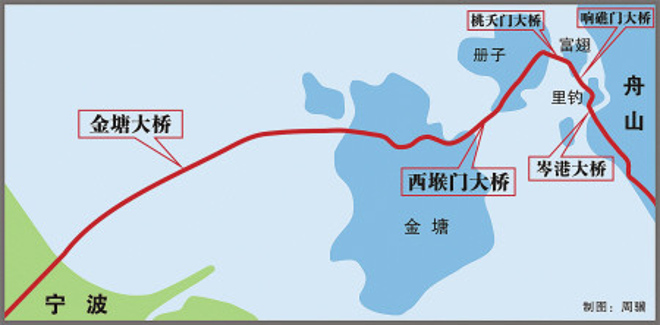
Five Cross-sea Bridges
The tour bus was being driven to the southeast on the mainland of Zhoushan, from Dinghai District to Putuo District, which lied at the south end, including Zhujiajian Island and Putuo Mountain Island. Between the main land and Zhujiajian Island there was also a great bridge, named Zhujiajian Bridge, connecting the Airport. Arriving at Zhuiajian Island, we took an aero boat to get to Putou Mount.
The mainland of Zhoushan has an area of 502.65 square km (including the tidal-flat area 26.48 square km), 44 km from east to west and 18 km wide from south to north. Zhoushan Islands have 1339 small and big island, 3306 reefs. The fifth national census of population showed that there were 103 inhabited islands and one million people living there. As a child when I studied geography I got to know Zhoushan Islands, thought that only some fishermen and women lived there and never thought that there were so many islands so large area and so many people living here. Wherever you stand and have a look, you can see one green island connecting the other. Zhoushan City is one of the municipalities directly under Zhejiang Province. Many people, including me, had thought Zhoushan city is subordinate to Ningbo City. Zhoushan City has jurisdiction over Putuo District, Dinghai District and two counties: Daishan, Shengsi, whose area has 1371 square km.
Shengsi County is a separate island, located in the direction of north east of Zhoushan, not far from Nanhui District of Shanghai. From the Luchao Harbor of Nanhui to the Small Yangshan Island of Shengsi County there is also a cross sea bridge, the famous East Sea Bridge, 32.5 km long, 3.5 km shorter than the Hanzhou Bay Bridge.
Putuo Mount is a separate island, with the area of 12.93 square km, looking at Shenjiamen of Zhoushan Islands opposite the other side of the sea. Putuo Mount is one of the four famous mounts of Buddhism, one of the first national important landscapes and famous sceneries, Named as “Sea and Heaven Land Purified by Buddhism” and “South Sea Sacred Landscape”. The island is shaped as a black dragon lying in the sea. On May 8 of 2007, Putuo Mount landscape and famous scenery of Zhoushan City was approved as a tourist attraction with 5A level by the National Tourist Administration. “On the sea there is an immortal mount, which lies in nothingness and etherealness.” Putuo Mount has become a tourist attraction famous at home and abroad, magical, sacred and mysterious, which is surrounded by the sea, charming sight, unique phantom, named as No 1 peace and quiet land of the world. Mount and forests, temple towers and cliff carvings, Sanskrit music and surf sound, full of mysterious colors of land purified by Buddhism. On the Island, there are luxuriant woods, ancient camphor trees everywhere, birds' twittering and fragrance of flowers -- an idyllic scene, named as “island arboretum”. In the court of Putuo Mount Temple there are two camphor trees, more than 600 years old, flourishing and no sign of aging, 50m tall, which is qualified to be called towering old trees. I thought in front of the old trees, 600 years of beaten times, still having luxuriant branches and leaves, this is because its root systems have been stretching through the rock seams into the deep layer and absorb nutrients continuously.
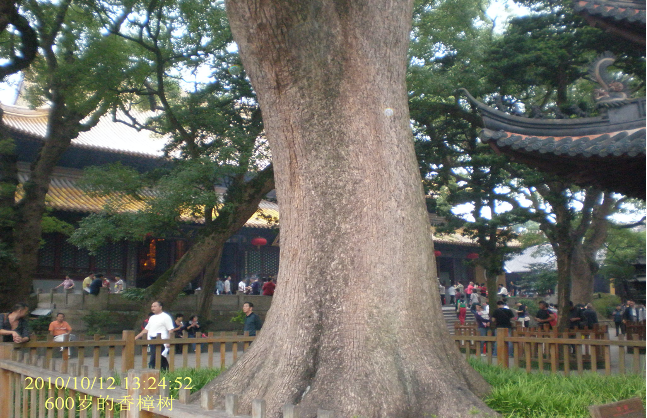
camphor tree, more than 600 years old
I have a particular affection toward big and tall trees. Wherever I see a big tree I will stay and gaze at it, up and down. Sturdy pines on Tai Mountain in Shangdong Province, nanmus on E’mei Mountain in Sichuan Province, ginkgoes on Hua’guo Mountain in Lianyungang City, Jiangsu Province, virgin gum trees in Australia, large plate root trees in Xishuangbanna, Yun’nan Province etc. have deeply impressed upon me. A lot of parents want their kids to grow up and become useful people and often compare persons of ability to big trees. If a person wants to become a talented body he or she must imitate a tree root system to stretch deep and wide to absorb nutrients from the deep land. As an advanced creature, a human being needs not only balanced material nutrients, but also rich spirit nutrients to nourish his or her own soul. Spiritual nutrients come from all sides of human beings’ civilization. If a person only accepts one thought, he or she will suffer from malnutrition. For decades, I rejected the religion, and turned pale at the mention of it. In fact, an atheist can also get in touch with the civilization of the religion, where there are also rich nutrients needed by our heart and soul. I do not believe in the God but I do believe that natural instincts of the human beings have a lot of kind-hearted inherent quality, mixed some evildoings at the same time, which the Christianity calls sins. I had a touch with a Chinese Christian, who said she was abdicated to smoking, drinking and gambling. She herself knew that those were sins but could not drive them away. Since she believed in Christianity, got to know the God and turned to him for help. She guarded against smoking, drinking and gambling, was determined to be a good daughter of the God in order to be accepted by the God after her death. She said if she had not depended on the strength of the God, she could not have overcome those evils. Zen Buddhism holds the view that the root of the pains of a human being’s life is fame and gain, which are poisonous snakes and make you forever not able to enjoy peace and calm. I do not believe in Buddhism’s preach about three existences, namely preexistence, nowadays existence and future existence. However, I hold that there are a lot of good thins existing in doctrine of Zen Buddhism. For example, it believes that originally one’s heart and soul was peaceful and quiet without any annoyances. The real world continues to disturb you with a lot of bothering things, mainly fame and gain, making you not able to keep balance, making you in a confused state of mind, and making you suffer from incomparable pains. Buddhists need always to practice meditation in order to put out the unbalanced fire in the soul. An atheist who does not believe in the god, or the three existences of Buddhism can also use the way of Christians and Buddhists for reference to placate pains and hurts of his or her own heart and soul, and it is unnecessary to live in No 1 peace and quiet land of the world. Christians can pray whenever and wherever they can, and a monk or a nun can practice meditation without hills and waters. Atheists can learn their spirit of exact demands, just like root systems of a big tree stretch deep into the ground without stop, take in nutrients continuously and realize the balance of materials and spirits and ensure the health of mind and body.
Oc. 19, 2018 in Xuzhou
Proofreading on Jan 4, 2019 in Xuzhou
Uploading on Aug. 9, 2023



